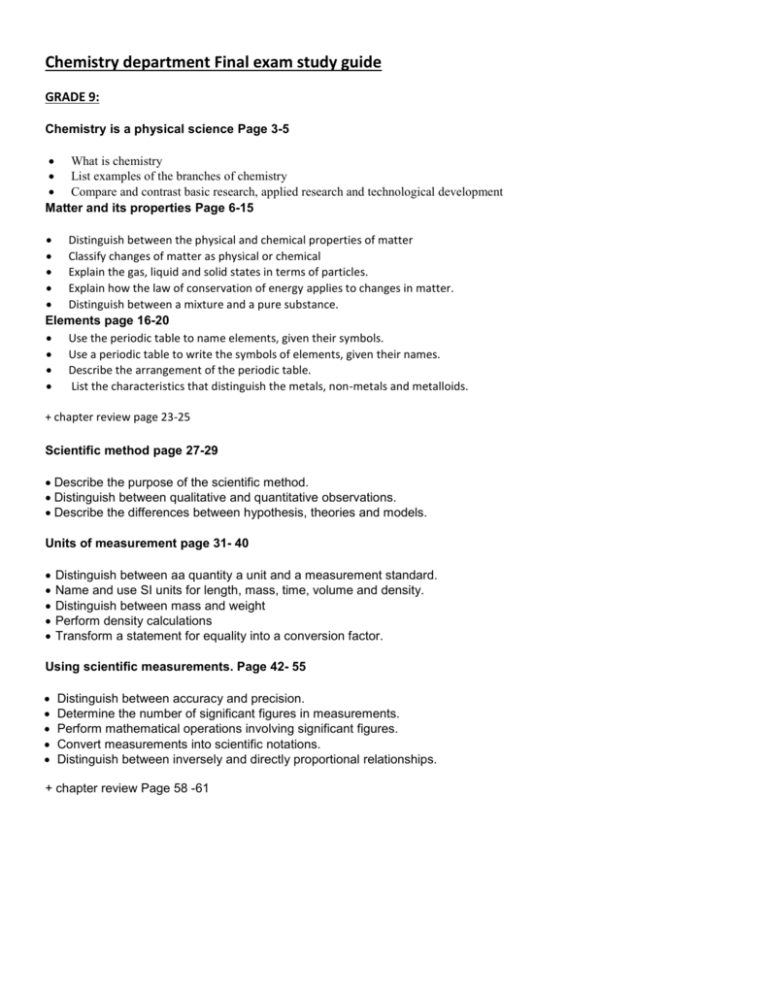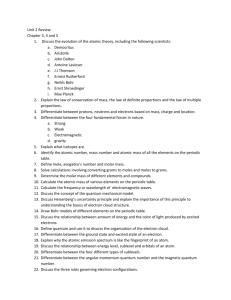Chemistry department Final exam study guide
advertisement

Chemistry department Final exam study guide GRADE 9: Chemistry is a physical science Page 3-5 What is chemistry List examples of the branches of chemistry Compare and contrast basic research, applied research and technological development Matter and its properties Page 6-15 Distinguish between the physical and chemical properties of matter Classify changes of matter as physical or chemical Explain the gas, liquid and solid states in terms of particles. Explain how the law of conservation of energy applies to changes in matter. Distinguish between a mixture and a pure substance. Elements page 16-20 Use the periodic table to name elements, given their symbols. Use a periodic table to write the symbols of elements, given their names. Describe the arrangement of the periodic table. List the characteristics that distinguish the metals, non-metals and metalloids. + chapter review page 23-25 Scientific method page 27-29 Describe the purpose of the scientific method. Distinguish between qualitative and quantitative observations. Describe the differences between hypothesis, theories and models. Units of measurement page 31- 40 Distinguish between aa quantity a unit and a measurement standard. Name and use SI units for length, mass, time, volume and density. Distinguish between mass and weight Perform density calculations Transform a statement for equality into a conversion factor. Using scientific measurements. Page 42- 55 Distinguish between accuracy and precision. Determine the number of significant figures in measurements. Perform mathematical operations involving significant figures. Convert measurements into scientific notations. Distinguish between inversely and directly proportional relationships. + chapter review Page 58 -61 The atom: from philosophical idea to scientific theory. Page 63- 67 Explain the laws of conservation of mass, the law of definite proportions and the law of multiple proportions. Summarize the five essential points of Dalton’s atomic theory. Explain the relationship between Dalton’s atomic theory and the laws of conservation of mass, definite proportions and multiple proportions. The structure of the atom. Page 68-72 Summarize the observed properties of cathode rays that led to the discovery of the electron. Summarize the experiment carried out by Rutherford and his coworkers that led to the discovery of the nucleus. List the properties of protons, neutrons, and electrons. Define atom. Counting atoms Page 73- 83 Explain what isotopes are. Define atomic mass and atomic number and describe how they apply to isotopes. Given the identity of nuclide, determine its number of protons, neutrons and electrons. Define a mole, Avogadro’s constant, molar mass and state how all three are related + All summary sheets given to students + copybook + all worksheets, weeklies and quizzes + lab safety rules GRADE 10: History of the periodic table Explain the role of Mendeleev and Moseley in the development of the periodic table. Describe the modern periodic table. Explain how the periodic law can be used to predict the physical and chemical properties of elements. Describe how the elements belonging to a group of the periodic table are interrelated in terms of atomic number. Electron configuration and the periodic table Describe the relationship between electrons in sublevels and the length of each period of the periodic table. Locate and name the four blocks of the periodic table. Explain the reasons for these names.(w2) Discuss the relationship between group configurations and group numbers Describe the locations in the periodic table and the general properties of the alkali metals, the alkaline-earth metals, the halogens, and the noble gases Electron configuration. List the total number of electrons needed to fully occupy each main energy level. State the aufbaw principle, the pauli exclusion principle, and hund's rule. Describe the electron configuration for the atoms of any element using orbital notation, electron configuration notation, noble-gas notation. List the total number of electrons needed to fully occupy each main energy level. State the Aufbau principle, the Pauli exclusion principle, and Hund's rule. Describe the electron configuration for the atoms of any element using orbital notation, electron configuration notation, noble-gas notation. Stoichiometery Introduction to stoichiometry Ideal stoichiometric calculations Introduction to stoichiometry Ideal stoichiometric calculations [mole-mole conversion,mole mass conversion, mass mole conversion, mass mass conversion, mole volume conversion, volume mole conversion] [stp and rtp conditions] Limiting reactants and percentage yield Types of mixtures Distinguish between heterogeneous and homogeneous mixtures. List three different solute-solvent combinations. Compare the properties of suspensions, colloids, and solutions. Distinguish between electrolytes and non-electrolyte. The solution process: List and explain three factors that affect the rate at which a solid solute dissolves in a liquid solvent. Explain solution equilibrium, and distinguish among saturated, unsaturated, and supersaturated solutions. Explain the meaning of “like dissolves like” in terms of polar and nonpolar substances. List the three interactions that contribute to the enthalpy of solution, and explain how they combine to cause dissolution to be exothermic or endothermic. Compare the effects of temperature and pressure on solubility. Concentration of solution: Given the mass of solute and volume of solvent, calculate the concentration of a solution. Given the concentration of a solution, determine the amount of solute in a given amount of solution. Given the concentration of a solution, determine the amount of solution that contains a given amount of solute. Compounds in aqueous solutions Write equations for the dissolution of soluble ionic compounds in water. Predict whether a precipitate will form when solutions of soluble ionic compounds are combined, and write net ionic equations for precipitation reactions. Compare dissociation of ionic compounds with ionization of molecular compounds. Draw the structure of the hydronium ion, and explain why it is used to represent the hydrogen ion in solution. Distinguish between strong electrolytes and weak electrolytes. + all worksheets + summary sheets+ copy book + all weeklies and quizzes + lab safety rules Grade 11 The quantum model of the atom List the four quantum numbers and describe their significance. Relate the number of sublevels corresponding to each of an atom’s main energy levels, the number of orbitals per sublevel, and the number of orbitals per main energy level. Electron configurations: List the total number of electrons needed to fully occupy each main energy level. State the Aufbau principle, the Pauli exclusion principle, and Hund’s rule. Describe the electron configurations for the atoms of any element using orbital notation, electronconfiguration notation, and, when appropriate, noble-gas notation. Electron configuration and the periodic properties. Define atomic and ionic radii, ionization energy, electron affinity, and electronegativity. Compare the periodic trends of atomic radii, ionization energy, and electronegativity, and state the reasons for these variations. Electron configuration and the periodic properties. Define valence electrons, and state how many are present in atoms of each main-group element. Compare the atomic radii, ionization energies, and electronegativities of the d-block elements with those of the main-group elements. Covalent bonding and molecular compounds: Define molecule and molecular formula. Explain the relationships among potential energy, distance between approaching atoms, bond length, and bond energy. State the octet rule. List the six basic steps used in writing Lewis structures. Explain how to determine Lewis structures for molecules containing single bonds,multiple bonds, or both. Molecular geometry VSEPR theory. Predict the shapes of molecules or polyatomic ions using VSEPR theory. Describe dipole-dipole forces, hydrogen bonding, induced dipoles, and London dispersion forces and their effects on properties such as boiling and melting points. Explain what determines molecular polarity. Hybridization: Explain hybridization. Describe sp, sp2, sp3, dsp3, d2sp3. Explain what determines the type of hybridization. Explain how the shapes of molecules are accounted for by hybridization theory. Worksheet+quizzes+weekly exams+copybook Graade 12 Oxidation-reduction rxn Assign oxidation numbers to reactant and product species. Define oxidation and reduction. Explain what an oxidation reduction reaction (redox reaction) is. Explain what must be conserved in redox equations. Balance redox equations by using the half-reaction method. Relate chemical activity to oxidizing and reducing strength. Explain the concept of disproportionation. Electrochemistry Identify parts of an electrochemical cell and their functions. Write electrode half reactions for cathodes and anodes. Describe the operation of voltaic cells, including dry cells, lead-acid batteries, and fuel cells. Identify conditions that lead to corrosion and ways to prevent it. Describe the relationship between voltage and the movement of electrons. Calculate cell voltage/potentials from a table of standard electrode potentials. Describe the nature of electrolytic cells. Describe the process of electrolysis in the decomposition of water and in production of metals. Explain the process of electroplating. Describe the chemistry of a rechargeable cell. Using Nernst equation to find cell voltage under nonstandard conditions. Describe Concentration cells and how to find cell voltage. Reaction energy Define internal energy and its calculation Define temperature and state the units in which it is measured. Define heat and state its units. Perform specific-heat calculations. Explain enthalpy change, enthalpy of reaction, enthalpy of formation, and enthalpy of combustion. Explain the relationship between enthalpy change and the tendency of a reaction to occur. Worksheet+quizzes+weekly exams+copybook





